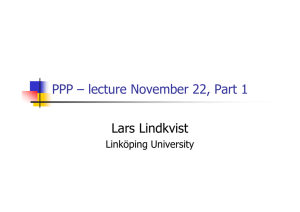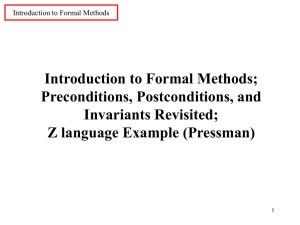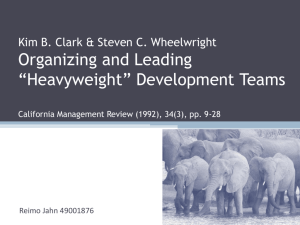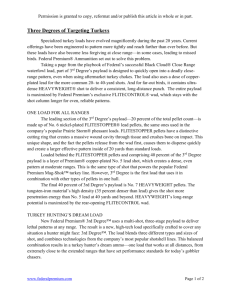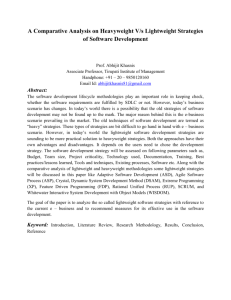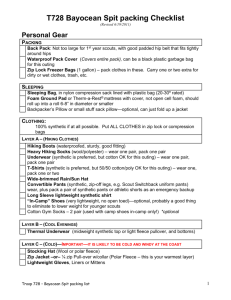Managing Challenges of Heavyweight Team
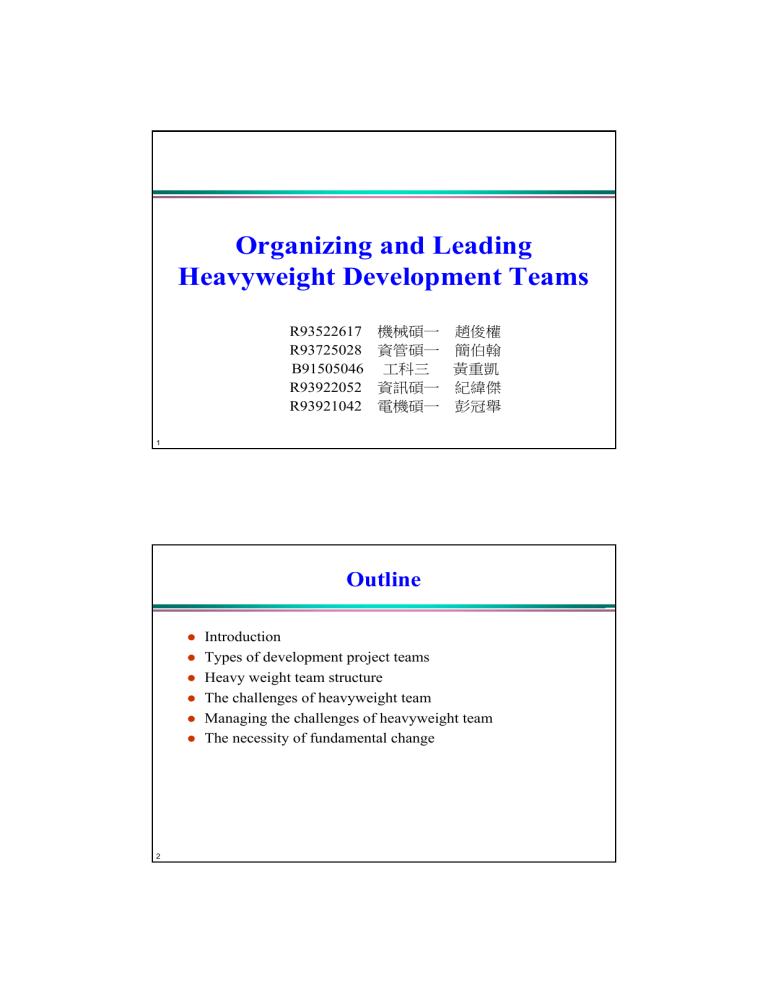
2
1
Organizing and Leading
Heavyweight Development Teams
R93522617 機械碩一 趙俊權
R93725028 資管碩一 簡伯翰
B91505046 工科三 黃重凱
R93922052 資訊碩一 紀緯傑
R93921042 電機碩一 彭冠舉
Outline z Introduction z Types of development project teams z Heavy weight team structure z The challenges of heavyweight team z z
Managing the challenges of heavyweight team
The necessity of fundamental change
3
Introduction z Integration of specialized capabilities is important for product & process development.
z In mature firms with strong functional groups, organizing and leading an effective development effort is a major under taking. z Four types of project team structures
Function team structure
Lightweight team structure
Heavyweight team structure
Autonomous team structure
4
Function Team Structure
FM FM
ENG MFG MKG
Function manager
(FM )
Working level
5
Lightweight Team Structure
Liaison (L)
Area of strong PM influence
Project manager (PM )
FM FM FM
ENG MFG MKG
Function manager
(FM )
Working level
L L
6
PM
Heavyweight Team Structure
Market
FM FM FM
ENG MFG MKG
Core
(C)
C C
Concept
8
7
Autonomous Team Structure
FM FM FM
ENG MFG MKG
Market
PM
Core
(C)
C C
Concept
Heavy Weight Team Structure z Example: Bandit Pager
18 months, half time of a normal project of such magnitude
Five sigma at the end of 18 months
Product reliability is higher than standard
Some lessons are transferred to other parts
9
The Challenges of Heavyweight Team z z z z z
Conflict with the functional organization
Turn into autonomous team
Insufficient direction or vague bound
Support activities are vulnerable.
Clear priorities, team members do more actual work in the support areas.
Balance between project and organization
Lack of depth
More testing, reviewed by expert
10
Managing Challenges of Heavyweight Team z z
Problems with depth in technical solutions and allocations of support resources suggest the tension that exists between heavyweight teams and the functional groups.
Mechanisms and problems are grouped into six categories of management action
The project charter
The contract
Staffing
Leadership
Team responsibility
The executive sponsor
Managing Challenges of Heavyweight Team z The project charter
A heavyweight project team needs a clear mission.
A way to capture that concisely is in an explicit, measurable project charter that sets broad performance objectives and usually is articulated even before the core team is selected.
12
11
Managing Challenges of Heavyweight Team z The contract book
A charter lays out the mission in broad terms, in detail, the basic plan to achieve the stated goal.
Such documents range from 25 to 100 pages, depending on the complexity of the project and level of detail desired by the team and senior management before proceeding.
Contract Book Major Sections
13 z Executive summary z Business plan and purposes z z
Development plan
Schedule
Materials
Resources
Product design plan z z
Quality plan
Manufacturing plan z Project deliverables z Performance measurement and incentives
14
Managing Challenges of Heavyweight Team z Staffing
A group of cross-functional members
Core team members from primary function
The difference between them is that the core team members manage the total projects.
z Project leadership – five major roles
Direct market interpreter
Multilingual translator
Direct engineering manager
Program manager “in motion”
Concept infuser
15
Managing Challenges of Heavyweight Team z z
Responsibilities of core team members
Functional hat accountabilities
Ensuring functional expertise on the project
Representing the functional perspective on the project
Team hat accountabilities
Sharing responsibility for team results
Sharing responsibility for ensuring effective team processes
The executive sponsor
Typically the vice president of department
Senior management communicate with project team through them.
They are also coach or mentor for the heavyweight project leader.
16
The Necessity of Fundamental Change z Required changes of “heavy” team
Fundamental behavior of engineers, designers, manufacturers, and marketers in their day-to-day work.
Example: Two teams to develop a small computer system with an identical custom-designed microprocessor chip z Heaviness is not just a matter of structure and mechanism, but of attitudes and behavior. Those intent on using teams for platform projects and willing to make the basic changes can enjoy substantial advantages of focus, integration, and effectiveness.
